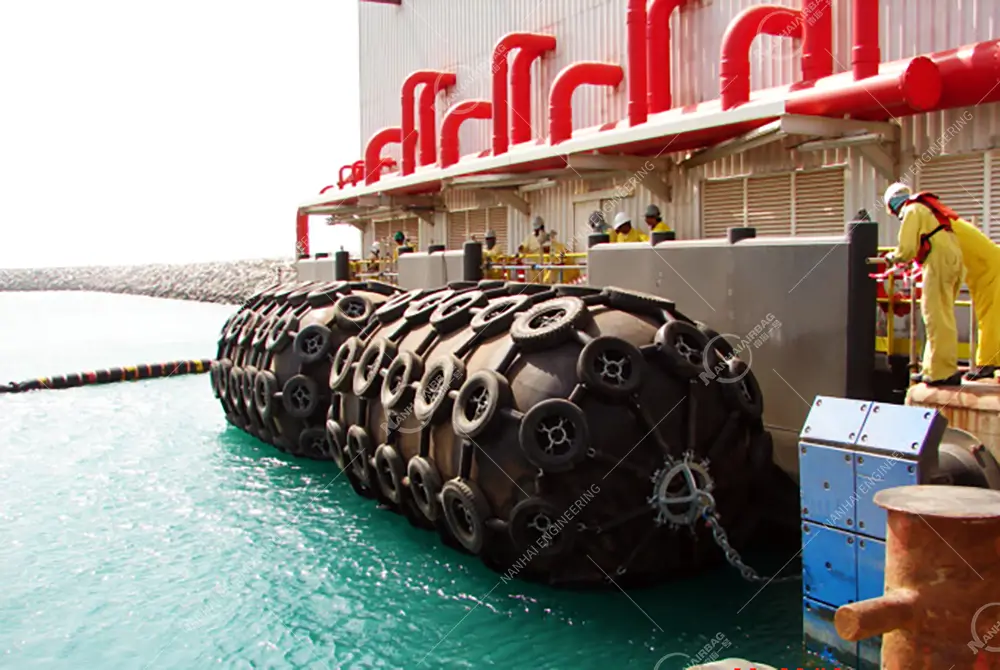Selection Of Ship Launching Airbags
06/13/2025The role of marine airbags in the process of ship launching
06/16/2025Characteristics of Wrapped Pneumatic Rubber Fenders
Why Are Pneumatic Rubber Fenders So Important?
Today, ships are bigger and heavier, and docks are busier. When ships come close to docks or other ships, strong impacts can happen. Without proper protection, these impacts can damage both the ship and the dock, and even cause serious accidents. This is why wrapped pneumatic rubber fenders are so important. They absorb shock, keep ships safely away from docks, and protect both the ship and the port.

What Are the Main Characteristics of Wrapped Pneumatic Rubber Fenders?
Durable rubber material that resists pressure
Flexible structure for shock absorption and energy dissipation
Encased in a protective wrapping for resistance to abrasions, cuts, and heavy impacts
Reliable performance under different sea conditions, strong waves, or heavy mooring pressure
Easy installation, low maintenance, and a long service life — reducing operational costs
Encased in Durable Layers of Rubber
The wall of a pneumatic fender usually has three layers of rubber. The inner layer seals in the air. The middle layer strengthens the fender and helps it hold pressure under heavy compression. The outer layer is made of strong rubber that resists abrasions and prevents damage.
NANHAI pneumatic rubber fenders have their intellectual property. They are made with a special integral wrapping technique — there are no seams in the wall. This makes them much less likely to break under pressure. Tests show that this method lets the fender’s wall be thinner while retaining its toughness, softness, energy absorption, and resistance to repeated impacts.
Real-Life Application — A Supertanker’s Safe Docking
In August 2000, a supertanker weighing 300,000 tons was docking near another ship in the South China Sea. The sea was rough, with strong winds and heavy waves. The ship used 4 pneumatic rubber fenders from different makers — 2 from China, 1 from the UK, and 1 from Singapore — to keep a safe distance during docking.
When strong waves and momentum put heavy pressure on the fenders, the fender made in Singapore burst, while the two Chinese fenders stayed strong and undamaged. This shows that Chinese fenders made with their integral wrapping technique are more reliable and less likely to break.
NANHAI Pneumatic Rubber Fenders
If you’re looking for a way to keep your ships, docks, or other marine structures safe, wrapped pneumatic rubber fenders might be your best solution. Contact Nanhai for more detailed information and a free quotation.
People Also Ask (Related Questions)
What are pneumatic fenders used for in ship docking?
Pneumatic rubber fenders are used to protect ships and docks during docking and mooring. They absorb shock and reduce damage when ships come close to each other or the dock. This helps keep both the ship and port safe.
How do pneumatic fenders perform under heavy pressure?
Wrapped rubber fenders perform very well under heavy pressure. The multilayer rubber structure, together with the wrapping technique, lets them absorb large amounts of energy without bursting or losing their shape.
What’s the difference between pneumatic fenders and marine airbags?
Pneumatic rubber fenders and marine airbags are different in their main use and structure. Fenders are designed to absorb collision energy and protect ships and docks, while marine airbags are used for launching, lifting, or moving ships and heavy structures. Each is made to handle a unique set of pressures and conditions.
Are ship airbags a viable alternative to rubber fenders?
Ship airbags can be a helpful tool in many operations, but they’re not a complete substitute for rubber fenders. Fenders specialize in protecting ships during docking, while airbags are used more for launching or heavy lifting. So it’s safest to use both where appropriate.
How long do pneumatic rubber fenders typically last?
Pneumatic rubber fenders typically last 10–15 years or even longer with proper care and maintenance. Durable materials and strong wrapping help them perform safely under tough conditions for many years.
